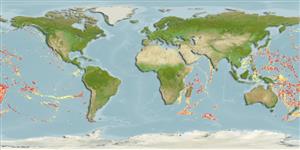Environment: milieu / climate zone / depth range / distribution range
Ecologia
marino batidemersale; distribuzione batimetrica 320 - 2000 m (Ref. 51655). Deep-water
Indo-West Pacific: from Tanzania, Comoros, Madagascar, to Samoa, Moluccas, Marquesas and New Guinea (Ref 9788); north to Taiwan (Ref. 129007),
Size / Peso / Age
Maturity: Lm ? range ? - ? cm
Max length : 13.0 cm TL maschio/sesso non determinato; (Ref. 9788)
Short description
Chiavi di identificazione | Morfologia | Morfometria
Spine dorsali (totale) : 6 - 9; Raggi dorsali molli (totale) : 8 - 9; Spine anali: 3 - 6; Raggi anali molli: 7 - 8; Vertebre: 30 - 32.
Mesopelagic, bathy-, and benthopelagic rare species, mostly occurring over continental and island slopes. Distinctive kasidoron larval and pre-juvenile stage in epipelagic waters. Zooplankton pickers, with small crustaceans in stomachs of both pre-juveniles and adults (Ref. 9788). The largest specimen collected from Taiwan (10.3 cm SL) is a mature female with two large ovaries containing many large, loose eggs (c. 0.6-0.7 mm); while three other specimens (9.72-10.1 and 10.07 cm SL) are mature males with well-developed testis (Ref. 129007).
Life cycle and mating behavior
Maturità | Riproduzione | Deposizione | Uova | Fecundity | Larve
Paxton, J.R., 1999. Gibberichthyidae. Gibberfishes. p. 2203. In K.E. Carpenter and V.H. Niem (eds.) FAO species identification guide for fishery purposes. The living marine resources of the WCP. Vol. 4. Bony fishes part 2 (Mugilidae to Carangidae). FAO, Rome. (Ref. 9788)
IUCN Red List Status (Ref. 130435: Version 2024-2)
Threat to humans
Harmless
Human uses
Pesca: di nessun interesse
Strumenti
Special reports
Download XML
Fonti Internet
Estimates based on models
Preferred temperature (Ref.
123201): 1.7 - 2.5, mean 2.1 °C (based on 25 cells).
Phylogenetic diversity index (Ref.
82804): PD
50 = 1.0000 [Uniqueness, from 0.5 = low to 2.0 = high].
Bayesian length-weight: a=0.01122 (0.00514 - 0.02450), b=3.04 (2.87 - 3.21), in cm total length, based on all LWR estimates for this body shape (Ref.
93245).
Trophic level (Ref.
69278): 3.1 ±0.30 se; based on food items.
Fishing Vulnerability (Ref.
59153): Low vulnerability (10 of 100).
